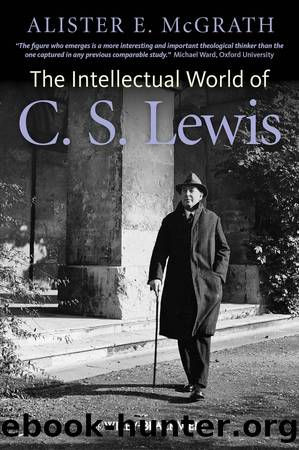The Intellectual World of C. S. Lewis by Alister E. McGrath

Author:Alister E. McGrath
Language: eng
Format: epub
Publisher: Wiley
Published: 2013-02-16T16:00:00+00:00
The Sun and Illumination as the Enablers of Knowledge
Lewis’s writings make frequent use of the analogy of the sun as a source of illumination. Any association between God and the sun is conspicuously absent from the Old Testament, on account of the risk of assimilation to Canaanite nature religions, which often involved the worship of the sun and other heavenly bodies as divine.70 The image features prominently in many classical mythologies – Egyptian, Greek, Roman, and Nordic71 – and plays a significant role in the medieval planetary symbolism that may have influenced Lewis’s construction of the “Chronicles of Narnia.”72
The imagery of light is deeply embedded in both biblical and classical sources. At an unknown date in the late Middle Ages, Oxford University adopted as its motto the Latin tag Dominus illuminatio mea – “the Lord is my light” (Psalm 27:1). Lewis could hardly have failed to notice this symbolism. Throughout the Christian Bible, the iconic dialectic between darkness and light is seen as correlated with the moral dialectic between evil and good, the spiritual dialectic between unbelief and faith, and the epistemic dialectic between doubt and knowledge.73 Although the contrast between light and dark is particularly striking in John’s gospel,74 this theme is found throughout the Bible, and subsequently in its interpretation within the Christian churches.
This imagery is, however, also found throughout the literature of the ancient world. Eastern religions make much use of the imagery of light and darkness.75 Yet in terms of the shaping of western literary and cultural conventions, it is arguable that the use of metaphors of light in the writings of Plato have perhaps proved most significant, especially as these are developed within neo-Platonism.76 “Light is more than just a metaphor; it is almost an instance of how intelligible reality generates its extended image.”77 Perhaps this factor, coupled with its extensive use in the Bible, led to the imagery of light or illumination being appropriated by many early Christian writers.
The most important of these is Augustine of Hippo (354–430), who made the imagery of light the cornerstone of his discussion of true knowledge, especially knowledge of divine things.78 It is not clear whether Augustine develops a coherent account of human cognition, based on the notion of illumination, or whether he simply saw light as a useful metaphorical organizing principle for his reflections. Nevertheless, there is no doubt of the importance of his fundamental conviction that true knowledge arises through the divine illumination of the human intellect. For Augustine, God is the intelligible sun who gives light to the mind and therefore brings intelligibility to what we see.79 At times, Augustine suggests that God illuminates the mind itself; at others, that God, like a sun, illuminates the extra-mental reality which is to be understood:80
Both the earth and light are visible; yet the earth cannot be seen unless it is illuminated by light . . . In the same way, things cannot be understood unless they are illuminated by something else as their own sun.
Download
This site does not store any files on its server. We only index and link to content provided by other sites. Please contact the content providers to delete copyright contents if any and email us, we'll remove relevant links or contents immediately.
Signature in the Cell: DNA and the Evidence for Intelligent Design by Stephen C. Meyer(3075)
The Secret Power of Speaking God's Word by Joyce Meyer(2980)
Real Sex by Lauren F. Winner(2968)
The Holy Spirit by Billy Graham(2894)
The Gnostic Gospels by Pagels Elaine(2472)
Jesus by Paul Johnson(2312)
Devil, The by Almond Philip C(2283)
23:27 by H. L. Roberts(2198)
The Nativity by Geza Vermes(2181)
Chosen by God by R. C. Sproul(2123)
All Things New by John Eldredge(2106)
Angels of God: The Bible, the Church and the Heavenly Hosts by Mike Aquilina(1932)
The Return of the Gods by Erich von Daniken(1898)
Angels by Billy Graham(1888)
Knowing God by J.I. Packer(1807)
Jesus of Nazareth by Joseph Ratzinger(1769)
Evidence of the Afterlife by Jeffrey Long(1745)
The Gnostic Gospel of St. Thomas by Tau Malachi(1739)
How To Be Born Again by Billy Graham(1731)
